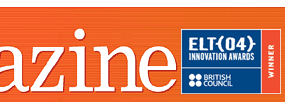 |
 |
 |
 |
 |
 |
|
|
|||||||||||||||||||||||||||||||||||||||||||||||||||||||||||||||||||||
COLUMNS |
Final in a series of articles on Business English issues
Since the September issue of MED Magazine, we have been looking at basic considerations of teaching Business English (BE) such as the difference between teaching general English and BE, classroom management, and the role of culture. This month I would like to discuss the importance of learner independence or self-reliance in BE. What students do to help themselves learn is key to a successful BE course. And how we can cultivate their sense of learner autonomy is crucial for a realistic, beneficial learning process. Individual learning style impacts the conception of student self-reliance in the BE acquisition process. Learning style basically implies how our students best recall information. With this style in mind, learning and teaching should be mirrored, but this is often not the case. Assuming or guessing at learning styles from both the participants' and teacher's side, can cause misunderstanding and disappointment. To avoid this, successful BE teaching must be based on open communication and then brought back to its student focus. Thus, differing learning styles must be considered and factored in for the entire course. Learning styles show a preference of how students learn or study in the most effective way. This is influenced by previous learning experience along with socio-linguistic and cultural factors. Explore and consider the difference in your students from Asia, Africa or the Middle East. Learning styles are moulded by their societal influence and experience.
When the learning styles are identified, the teacher has the chance to instil a sense of the students being in control of their own learning. In practical terms, focusing on their learning style is essential for BE students to see tangible results, both in their own learning and the group's progression on the whole. Moreover, emphasis on students' individual learning preferences enhances their self-esteem while avoiding boredom and burn-out. Based on your students' style of learning, you as the trainer can take steps for organising your course. The BE teacher should aim to give the participants tools to create a foundation to make learning a realistic, total process where the students are making maximum use of their time both inside and outside the classroom. In the early stages of any course, consider the following:
Involving students in the above points creates a framework for learning where learner self-reliance is a crucial element. This can be stimulated through discussion or surveys with these self-reflective ideas:
Self-reliance in the learning process Self-reliance signifies students taking charge of their own learning both inside and outside the lesson. With this heightened feeling of autonomy, students carry on the learning process between class meetings. Participants will notice how their independent learning efforts contribute to a unified process, linking self-reliance to classroom learning. BE teachers should constantly emphasize and cultivate a whole BE learning process: in and away from class time. They can observe, monitor, or overhear students in:
BE teachers can help their students by offering ways of improvement, suggestions and tips for enhancing learning. Your constant input will keep the momentum and motivation moving ahead for your students. To facilitate self-reliance, there should be an implementation of practical tools and methods throughout the entire course. Here are some suggestions:
For the BE learning process to be successful, teachers or trainers should remember that student motivation is of paramount importance. Motivation is at the centre of cultivating any learner self-reliance. As teachers, we convey the idea that the learning process is for the students' benefit, not ours. It is not to please us, but rather to enhance student motivation and self-esteem for their own sense of accomplishment. With each class or lesson, motivation has to be monitored, adjusted and boosted by the teacher whenever necessary. There ought to be regular, frank discussion of what is affecting your students' motivation. Job or personal demands may place constraints and cause frustrations for students trying to maintain their classroom work along with any self-study. On the other hand, if the students seem highly motivated, then sharing of how they manage this would only underline the key importance of motivation for the other students. Learner independence is yet another challenging issue for teaching BE. We can help put the students on the right path for getting the most out of their language learning experience. Once they have a heightened awareness of how much they can affect their own learning, self-reliance becomes an integral component of the process. In BE particularly, this will only add to their self-esteem in preparing themselves as competent professionals in international business. Benson, P and Voller, P. Autonomy and Independence
in Language Learning. (Pearson Education, 1996) www.onestopenglish.com/business_esp www.besig.org www.iatefl.org/lisig www.esl.about.com www.teachingenglish.org.uk You'll find the following related material in this issue: |
||||||||||||||||||||||||||||||||||||||||||||||||||||||||||||||||||||
|
|
|||||||||||||||||||||||||||||||||||||||||||||||||||||||||||||||||||||